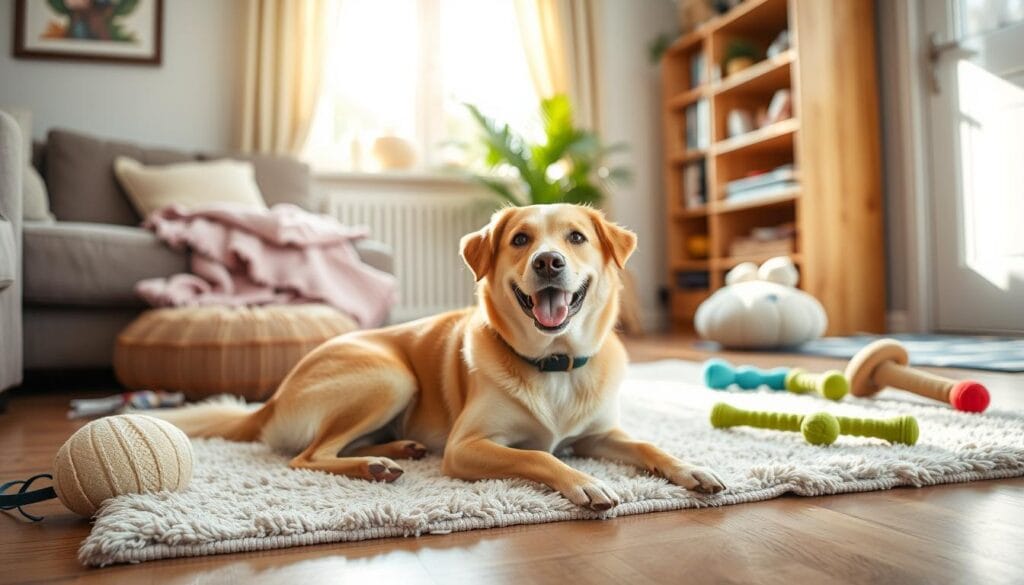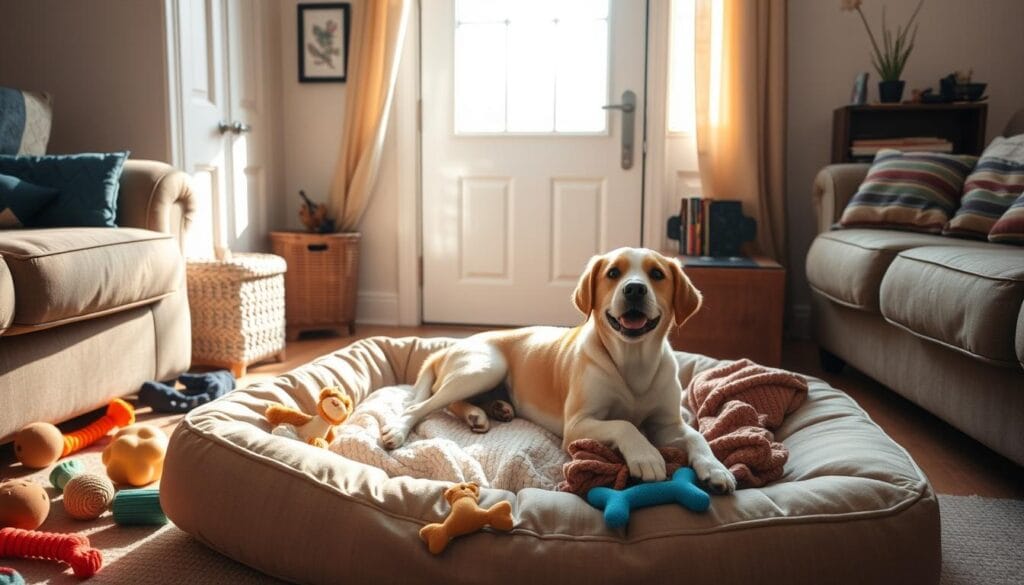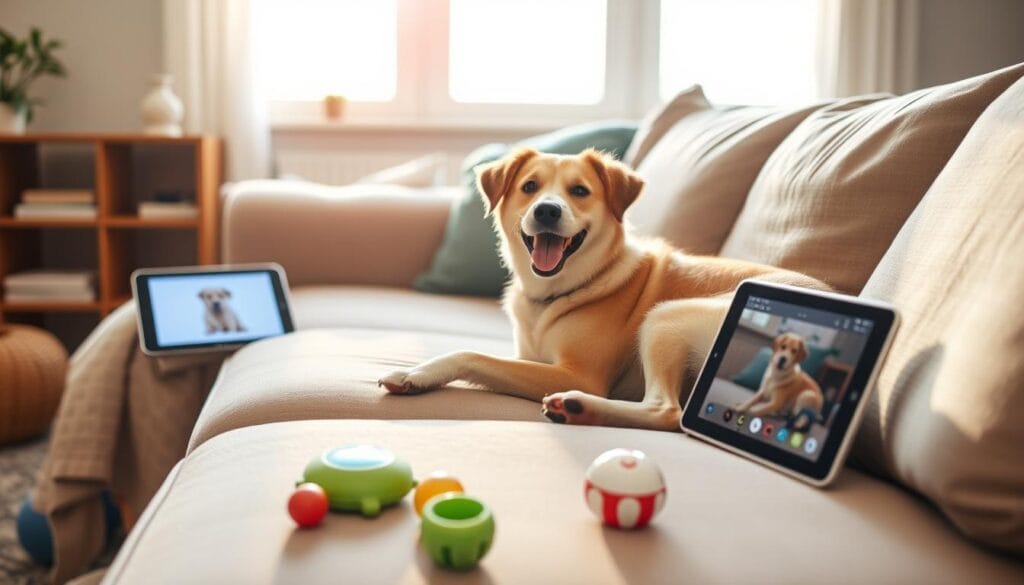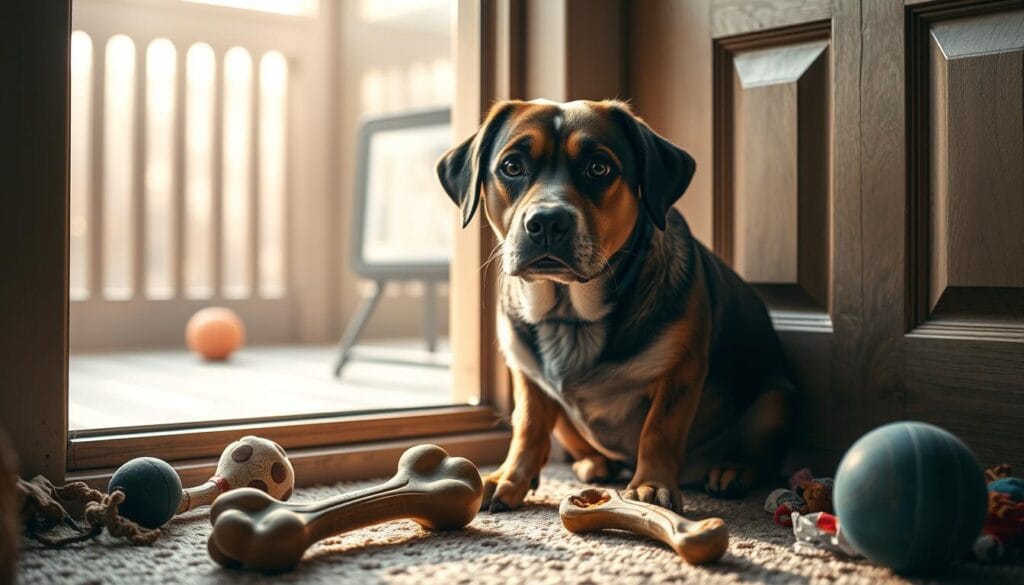When you have to leave your dog at home, it’s important to keep them safe and happy. Dogs are social and can get anxious when left alone. But, with the right steps, you can make your dog feel secure and happy when you’re away.

Key Takeaways
- Understand your dog’s needs and create a routine to prevent separation anxiety.
- Properly dog-proof your home and provide a safe, comfortable space for your pet.
- Choose the right toys and activities to keep your dog engaged and mentally stimulated.
- Gradually train your dog to be alone, using positive reinforcement techniques.
- Utilize technology and schedule regular exercise and socialization to support your dog’s well-being.
Understanding Your Dog’s Needs While Alone
When your furry friend is left alone, it’s key to know their needs. A consistent routine is vital for a happy dog when they’re by themselves.
The Importance of Routine
Dogs love routine. A regular schedule for meals, walks, and playtime helps them feel less stressed. This routine reduces anxiety and confusion when you’re not there.
Signs of Separation Anxiety
Many lonely dogs suffer from separation anxiety. Look out for signs like barking, whining, or howling. Destructive behavior and accidents are also red flags. If you see these, talk to a vet or trainer to help your dog.
Environmental Enrichment for Dogs
Keeping dogs home alone busy is important. Environmental enrichment like puzzle feeders and toys keeps them entertained. These activities also keep their minds and bodies active.
| Environmental Enrichment Idea | Benefits |
|---|---|
| Puzzle Feeders | Encourages problem-solving and keeps your dog engaged while eating |
| Interactive Toys | Provides mental stimulation and reduces boredom |
| Rotating Toys | Maintains your dog’s interest by introducing new playthings regularly |
“A tired dog is a happy dog. Engaging activities while you’re away can reduce dog separation anxiety and keep them happy.”
Preparing Your Home for Your Dog
When your dogs are left alone at home, it’s crucial to create a safe and comfortable environment for their well-being. Proper dog-proofing and setting up cozy sleeping areas can go a long way in ensuring your dogs left alone feel secure and content. (Dog Alone)
Dog-Proofing Spaces
Start by thoroughly dog-proofing your home to prevent any potential hazards. Examine each room and take the necessary steps to make it dog-friendly. This may include:
- Securing cabinets and drawers to prevent access to harmful items
- Hiding electrical cords and loose wires that could be chewed on
- Removing or securing any fragile or valuable items within your dog’s reach
- Blocking off any areas that may be unsafe, such as stairways or balconies
Safe and Comfortable Sleeping Areas
Provide your dog with a cozy and inviting sleeping space, such as a soft bed or a designated area in a quiet corner of your home. Consider adding familiar toys, blankets, or items with your scent to help your dog alone feel more at ease. Keep the sleeping area clean, well-ventilated, and away from any potential disturbances or hazards. (Dog Alone)
“A comfortable and familiar sleeping space can greatly reduce stress and anxiety for dogs home alone.”
By creating a safe and welcoming environment, you can help your dog feel relaxed and content when left to their own devices. This can contribute to their overall well-being and reduce the likelihood of destructive or problematic behaviors. (Dog Alone)
Choosing the Right Toys and Activities
When your dog is home alone, the right toys and activities can make a big difference. Interactive toys and puzzle feeders keep them entertained and happy. They also help prevent boredom and keep your dog’s mind sharp. (Dog Alone)
By changing up the toys, you keep your dog interested and prevent them from getting bored or destructive.
Interactive Toys to Keep Your Dog Engaged
Interactive toys like treat-dispensing balls and puzzle toys are great for lonely dogs. They make your dog work for treats, which keeps them busy and happy. These toys also challenge your dog’s problem-solving skills. (Dog Alone)
Puzzle Feeders for Mental Stimulation
Puzzle feeders are another great way to keep dogs left alone mentally active. They need to figure out how to get their food, which keeps them focused. Using puzzle feeders can help stop boredom and bad behaviors like barking or chewing.
Rotating Toys to Maintain Interest
- Change your dog’s toys often to keep them interested.
- Swap out toys every few days or weeks to keep things exciting.
- Bring in new toys to keep your dog alone entertained.
By offering a variety of toys and activities, your dog will stay happy and engaged when they’re alone. This helps prevent separation anxiety and bad behaviors. (Dog Alone)
Establishing a Safe Space
Keeping your dog safe and comfy when alone is key. A cozy, safe space helps them feel secure. It also helps with dog separation anxiety.
Creating a Cozy Den for Your Dog
Set up a special “den” for your dog alone time. It could be a quiet room corner, a spare bedroom, or a crate with familiar things. Make it a place where your dogs home alone feel safe and cozy.
- Give a soft, comfy bed or blankets for snuggling.
- Add their favorite toys, chews, or puzzles for fun.
- Use a piece of your clothing or an item with your scent to calm them.
- Make sure the area is well-ventilated and comfy for your dog.
Using Crates Effectively
Crates are great for a safe space when you’re away. But, it’s crucial to introduce and use them right. This way, your dog feels safe and not stressed.
- Let your dog get used to the crate at their own pace.
- Give treats and praise when they go into the crate willingly.
- Don’t use the crate as punishment; it’s a safe spot for your dog.
- Make sure the crate is the right size for your dog to move around easily.

With a cozy den and proper crate use, your dog will feel safe when left dog alone. This reduces dog separation anxiety and bad behaviors.
Training Your Dog for Alone Time
As a dog owner, it’s key to teach your dog to handle being alone. Using good training methods can ease dog separation anxiety. It also makes sure your dog is happy and safe when dogs left alone. (Dog Alone)
Basic Commands for Obedience
Begin by making sure your dog knows basic commands like “sit,” “stay,” and “come.” These skills do more than just strengthen your bond. They also help your dog stay calm and listen, even when you’re not there. (Dog Alone)
Gradual Alone Time Training
Start by leaving your dog alone for short times and then increase it slowly. This way, your lonely dogs get used to being without you without feeling too stressed. (Dog Alone)
Positive Reinforcement Techniques
- Give treats, praise, and their favorite toys when they’re calm and relaxed after you leave and come back.
- Don’t scold or punish your dog for any anxious behaviors. It can make things worse.
- Use positive reinforcement to build their confidence and independence.
By using these training methods, your dog will feel safe and happy when left alone. This reduces dog separation anxiety and keeps them well.
Using Technology to Your Advantage
In today’s world, technology offers many ways to keep your dogs home alone safe and happy. You can use pet cameras and automatic feeders to help. These tools make sure your dog is okay, even when you’re not there. (Dog Alone)
Pet Cameras and Monitoring Solutions
Pet cameras are now very popular. They let you see and hear your dog alone from anywhere. They also have cool features like two-way audio, motion detection, and treat dispensing. (Dog Alone)
With these cameras, you can check on your dogs left alone anytime. This way, you can quickly solve any problems and keep them safe.
Automatic Feeders for Scheduled Meals
It’s important to feed your dog at the same time every day. Automatic feeders make this easy. They give out the right amount of food at the right time. (Dog Alone)
This keeps your dog from going hungry and gives them a routine. It’s great for dogs that get anxious when left alone.
Technology lets you watch over your dog and meet their needs, even when you’re not there. It makes a safe and fun place for your dogs home alone. You can leave them for a bit without worrying. (Dog Alone)

Scheduling Regular Exercise and Socialization
When your dog is left alone, it’s key to keep them happy and healthy. Regular exercise and socialization are vital. They help your lonely dogs or dogs left alone feel content. (Dog Alone)
Importance of Daily Walks
Daily walks are great for your dog’s health and happiness. They help prevent boredom and anxiety when you’re away. A brisk walk before you leave can make your dog tired and relaxed. (Dog Alone)
This routine gives your dog a sense of comfort and structure. It helps them feel secure when they’re home alone.
Dog Park Visits and Playdates
Socializing your dog is a smart way to meet their need for companionship. Dog park visits or playdates with friends can be a big help. They give your dog the chance to interact and have fun. (Dog Alone)
These activities help your dog release energy and engage in natural behaviors. They also help your dog feel more comfortable when left alone.
| Benefits of Regular Exercise and Socialization | Potential Risks of Neglecting Exercise and Socialization |
|---|---|
| Reduces boredom and separation anxiety Promotes physical and mental well-being Helps dogs left alone feel more comfortable and secure | Increased destructive behaviors, such as chewing or barking Development of behavioral issues, like excessive whining or restlessness Negative impact on the overall health and happiness of lonely dogs |
By focusing on regular exercise and socialization, you can keep your dog happy and healthy when you’re away. This ensures they stay well-adjusted and content at home. (Dog Alone)
“A tired dog is a good dog. Regular exercise and playtime can do wonders for a dog left alone.”
Signs Your Dog is Unhappy or Stressed
As a devoted pet parent, it’s crucial to be attuned to your furry companion’s emotional well-being. This is especially true when they’re left home alone. Recognizing the signs of dog separation anxiety, distress, or discomfort can help you provide the love and support your pup needs.
Behavioral Changes to Watch For
When dogs home alone, they may show various behavioral shifts. These signs indicate they’re not feeling their best. Keep an eye out for these common signs: (Dog Alone)
- Excessive barking, whining, or howling
- Destructive chewing or scratching, particularly around doors and windows
- Loss of appetite or disinterest in favorite treats
- Excessive pacing, circling, or restlessness
- Accidents in the house, despite being housetrained
- Excessive drooling or panting, even in a comfortable environment
How to Identify Excessive Barking or Chewing
While some barking or chewing is normal for lonely dogs, it’s key to tell the difference. Excessive or persistent barking, whining, or destructive chewing can be signs of separation anxiety or distress.
Watch the frequency, duration, and intensity of these behaviors. If your pup barks or chews for long periods or if these behaviors get worse when you’re away, it’s time to seek professional help.

“The key to helping a dog with separation anxiety is to understand their triggers and work on building their confidence and independence when alone.”
Seeking Professional Help When Needed
At times, your dog’s well-being while alone may require professional help. Knowing when to see a vet or a dog trainer can be crucial. It helps in tackling severe separation anxiety or behavioral problems.
When to Consult a Veterinarian
If your dog still shows distress when left alone, even with a comfy space, it’s time to see a vet. They can check your dog’s health and find any hidden medical issues. Your vet might suggest medication or other treatments for your dog’s anxiety.
Finding a Qualified Dog Trainer or Behaviorist
For complex cases of separation anxiety or behavior, a professional dog trainer or behaviorist is key. They can spot the problem and create a special training plan. Choose experts who focus on separation anxiety and use positive methods to help your dog feel better when alone.
FAQ
What are the signs of separation anxiety in dogs?
Dogs with separation anxiety might bark or whine a lot. They might also chew or scratch things. Other signs include urinating inside, pacing, or acting distressed when you leave.
How can I create a comfortable environment for my dog when home alone?
Make a cozy spot for your dog, like a crate or den. Add familiar bedding and toys. Keep it well-ventilated and at a good temperature. Place it away from loud noises and busy areas.
What types of toys and activities can help keep my dog entertained while alone?
Get interactive toys like puzzle feeders and snuffle mats. Chew toys are good too. Change their toys often to keep them interested. Leaving the TV or radio on can also help.
How can I gradually train my dog to be comfortable being alone?
Begin with short alone times and slowly add more. Reward your dog with treats or praise for staying calm. This builds their confidence and independence.
What are some signs that my dog may be unhappy or stressed when left alone?
Watch for signs like barking, howling, or whining. Destructive actions like chewing or digging are also red flags. Look for anxiety signs like pacing, panting, or drooling.
When should I consult a professional for my dog’s alone time issues?
If your dog’s anxiety doesn’t get better, seek help. A vet or dog trainer can help find the cause and create a plan. They’ll work with you to help your dog feel better.
IMPORTANT ADDITIONS
Edited on , 26 NOV ,2024
Read more articles : https://petsfeeling.com/blog-2/
social media :
facebook : https://www.facebook.com/PetsFeeling0/
tiktok : https://www.tiktok.com/@pets.feeling
instagram : https://www.instagram.com/pets._.feeling/
youtube : https://www.youtube.com/@Pets-Feeling

